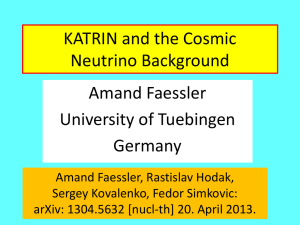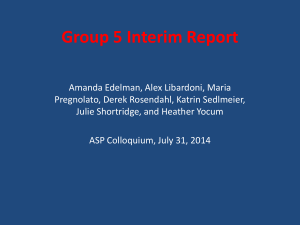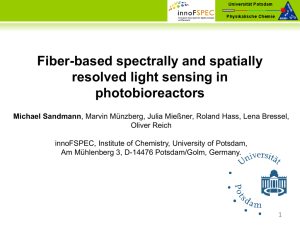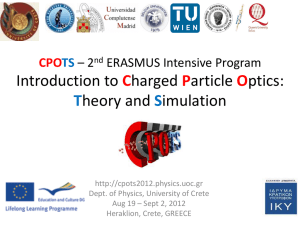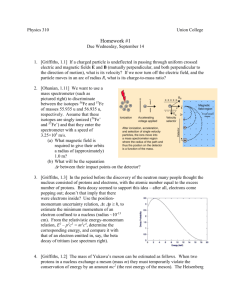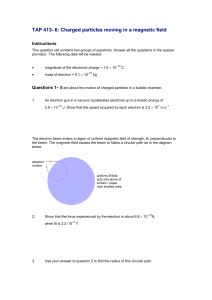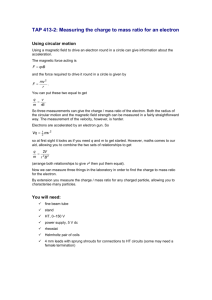nanp2003
advertisement
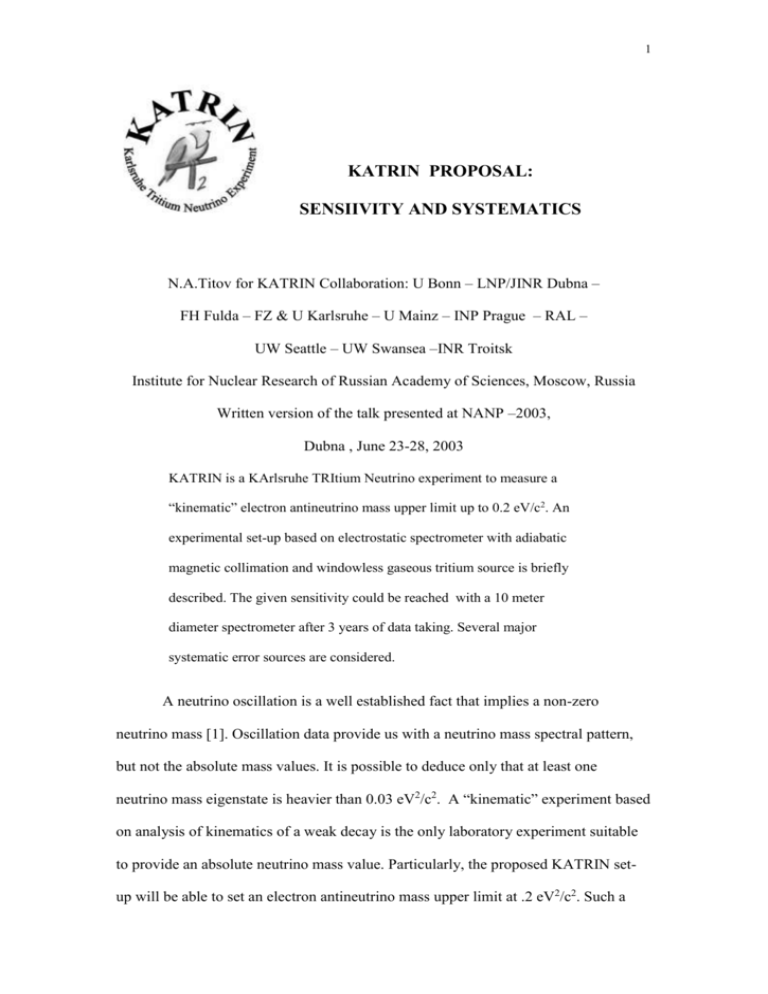
1 KATRIN PROPOSAL: SENSIIVITY AND SYSTEMATICS N.A.Titov for KATRIN Collaboration: U Bonn – LNP/JINR Dubna – FH Fulda – FZ & U Karlsruhe – U Mainz – INP Prague – RAL – UW Seattle – UW Swansea –INR Troitsk Institute for Nuclear Research of Russian Academy of Sciences, Moscow, Russia Written version of the talk presented at NANP –2003, Dubna , June 23-28, 2003 KATRIN is a KArlsruhe TRItium Neutrino experiment to measure a “kinematic” electron antineutrino mass upper limit up to 0.2 eV/c2. An experimental set-up based on electrostatic spectrometer with adiabatic magnetic collimation and windowless gaseous tritium source is briefly described. The given sensitivity could be reached with a 10 meter diameter spectrometer after 3 years of data taking. Several major systematic error sources are considered. A neutrino oscillation is a well established fact that implies a non-zero neutrino mass [1]. Oscillation data provide us with a neutrino mass spectral pattern, but not the absolute mass values. It is possible to deduce only that at least one neutrino mass eigenstate is heavier than 0.03 eV2/c2. A “kinematic” experiment based on analysis of kinematics of a weak decay is the only laboratory experiment suitable to provide an absolute neutrino mass value. Particularly, the proposed KATRIN setup will be able to set an electron antineutrino mass upper limit at .2 eV2/c2. Such a 2 study makes sense as there are two regimes for the neutrino mass scheme: hierarchical and quasi-degenerate (see Fig.1). In the hierarchical scheme mass eigenstates have a Fig. 1. Neutrino mass scheme. Hierarchical and quasi-degenerate parts are shown. The current experimental mass limit [2] as that of KATRIN are shown. different scale determined by m2atmospheric and m2solar with the heaviest mass about of 0.05 eV2/c2. In the quasi-degenerate scheme all neutrinos have about the same mass much larger than splitting. The latter scheme is somewhat favored by the observed large mixing angles of different mass eigenstates sinij 1 [1]. The neutrino mass in the quasi-degenerate scheme has a chance to be detected in the tritium experiment or this option could be mostly excluded. The tritium -decay is a super allowed transition. In the quasi-degenerate regime mass splitting 1-3 could be neglected and the electron spectrum is described by the well known formula: dN =K F(Z,E) p Etot (E0-E) [(E0-E)2 - m2]1/2 dE (1) Almost all of the spectrum data points holds (E0-E)2 >> m2 and the neutrino mass signature is a negative constant shift of the parabolic spectrum with respect to the background level (see Fig.2). 3 dN dE (E0-E)2 - m2 /2 (2) Fig. 2. The exact tritium -electron energy spectrum and its parabolic approximation. The neutrino mass signature is a shift of the parabolic part of the spectrum. The absolute data error bar increases for high intensity points. On the inserted graph the signal-to-error bar ratio is presented for different background levels. The absolute value of statistical error bar is a linear function of the distance from the endpoint (E0-E). The sensitivity to nonzero neutrino mass is steadily vanishing far from the spectrum endpoint as it is shown on the inserted graph in Fig.2. A real experimental parameter in the tritium decay experiment is a neutrino mass square, as could be seen from formula (1). During last 1015 years the experimental sensitivity to neutrino mass square was improved by about two orders of magnitude (see Fig.3). This was achieved by invention of an electrostatic spectrometer with an adiabatic magnetic collimation (AMC). AMC made it possible to decouple high resolution and high luminosity requirements. Amazingly, this idea 4 was independently developed by several researchers [2]. AMC is based on conservation (as an adiabatic invariant) for a charged particle moving through the Fig. 3. The electron antineutrino mass-square measurements summary for previous decade. magnetic field of the ratio of transversal kinetic energy to magnetic field strength: E trans B (3) For conservation of adiabatic invariant it only is required that along the trajectory of a moving particle the magnetic field variation should be small on the time scale of one gyration. The idea is that a tritium -decay takes place in a strong magnetic field within a large solid angle (see Fig.4). When electrons are transported to the low magnetic field region their moments become aligned along the magnetic field to fulfill conservation of adiabatic invariant. The aligned electron energy could be analyzed with an electrostatic spectrometer. To define the tritium decay solid angle electrons should pass the region with magnetic field Bmax somewhat stronger than one at decay 5 region. Finally, one got an integral spectrometer – a high pass filter at an electrostatic mirror potential U0 with a full width resolution: E | eU 0 | BAnalys BMax (4) Thus, the spectrometer resolution only is determined by a magnetic field ratio with an acceptance solid angle of the order of one ster and an arbitrary source diameter. Fig. 4. The operation principle of the electrostatic spectrometer with an adiabatic magnetic collimation. Electron moments are aligned along the guiding magnetic field after transition into the low field region and are analyzed with electrostatic barrier. The second invention is a windowless gaseous tritium source (WGTS) first used in the LANL experiment [8] and later significantly modified at Troitsk [10]. WGTS provides an excellent intensity of -electrons, has high uniformity and well controlled energy losses. The KATRIN project united almost all experts on the field with the aim to get ultimate sensitivity to m with an electrostatic spectrometer with adiabatic magnetic collimation and WGTS. The KATRIN set-up general view is presented in Fig. 5. The tritium -decay takes place inside WGTS surrounded by the differential pumping stations. The outgoing tritium is collected, purified and reinjected in the center of WGTS. The decay electrons are guided by magnetic field through WGTS and the cryotrapping section toward the pre- and main spectrometer. In order to have a low 6 Fig. 5. The KATRIN set-up general view. The tritium -decay takes place inside the windowless gaseous tritium source surrounded by the differential pumping stations. Decay electrons are guided by magnetic field through the cryotrapping section toward the pre- and main spectrometer. After being analyzed by an electrostatic mirror the decay electrons are registered by a semiconductor detector. spectrometer background the multiple differential pumping stations and cryotrapping sections have to reduce tritium partial pressure in the spectrometer compared with WGTS by a factor of 1016. Inside the pre- and main spectrometers the decay electron energies are analyzed by the electrostatic mirror formed by a set of electrodes. After being analyzed the decay electrons are registered by a segmented semiconductor detector. The total set-up length is up to 90m. Magnetic field values are 3.6T (WGTS), 6T (maximal field), 0.0003T (analyzing plane). The WGTS diameter is 90mm, main spectrometer diameter is 10m, spectrometer vacuum is up to 10-12 mbar. Evaluating the KATRIN set-up statistical sensitivity one should take into account that several parameters could be optimized but others are interrelated. The spectrometer resolution and acceptance define magnetic field ratios and, in turn, geometrical proportions of vessels. Technical limitations are a maximal diameter of the extra high vacuum spectrometer vessel (10m) and a maximal field in the super conducting magnets (6T). As will be discussed below, for the ultimate accuracy only the electrons leaving WGTS without inelastic scattering are useful. The source column density and acceptance angle are selected in such a way that the nonscattering fraction of outgoing decay electrons is near saturation. The spectrometer resolution improvement below 1 eV provides no sensitivity increase, as the effective 7 resolution is limited by roto - vibrational excitation of a recoil molecular ion (3HeT)+. At last, a data point distribution was optimized to reach maximal sensitivity. A parameter set for sensitivity calculations is presented in Table 1. Assuming systematic stat and background level of 10 mHz with parameters from Table 1 one could calculate that the KATRIN neutrino mass upper limit would be .2 eV (90% C.L.). Table. 1. KATRIN parameters. WGTS Spectrometer Measurements Tritium column density 51017 mol/cm2 Diameter 10 m. (effective 9 m) 3 years of data taking Diameter 90 mm. (effective 81 mm) Resolution E = .93 eV Optimized set of data points Acceptance angle 51o Tritium purity 95%. Considering the KATRIN systematics one should keep in mind that the neutrino mass signature is a drain of a part of -electron kinetic energy to its rest mass. All other competing sources of energy drain can simulate a neutrino mass at some extend. The energy flow chart is presented in Fig. 6. The main source of released energy is a nuclear mass difference. The released energy is modified by source molecule motion and excitation. A tiny effect is the influence of mother molecule excitation on the recoil ion excitation spectra shown by dashed arrow [4,5]. The space charge potential inside WGTS will decelerate the -electron when it is leaving the source. Different energy drains are listed at the lower part of the chart. The most significant are excitation of the recoil ion (3HeT)+ and -electron inelastic 8 Fig. 6. Energy flow chart. First line – corrections to the released energy. Second line – the nuclear mass difference is a released energy main source. Other lines – different energy drains. energy losses. All of them modify the endpoint energy E0 in formulas (1,2). It is crucial that one should distinguish two cases of endpoint modification: endpoint shift and endpoint broadening. In all practical cases tritium spectrum analysis keeps the endpoint energy as a free parameter and the endpoint shift is accounted leaving no damage. On the contrary, the endpoint broadening results in false m2 without any other signature. If broadening is described with Gaussian distribution, false m2 is determined by the distribution width [6]: m2 = - 2 2 (5) The recoil ion (3HeT)+ final states spectrum (FSS) is presented in Fig. 7. No method is proposed to measure it and theoretical calculations [4,5] are the only way to take it into account. To reduce the FSS influence it is proposed to measure only last 2025 eV of the tritium decay spectrum. The roto-vibrational part of FSS could not be excluded and it should be known very well. Two most sophisticated calculations [4,5] provide slightly different presentations of roto-vibrational FSS that results in m2 ambiguity about .001 eV2. 9 Fig. 7. Molecular ion (3HeT)+ excitation spectrum calculated by S.Jonsel e.a. [4] and A.Saenz e.a. [5]. On the inserted graph a roto-vibrational part of spectrum is presented. The -electron undergoes inelastic scattering in WGTS. When last 2025 eV of the tritium decay spectrum are analyzed only single and double scattering should be accounted (see Fig.8). The energy loss spectrum will be measured with a high accuracy with monoenergetic electrons from an electron gun placed at the rear side of WGTS like in the existing experiments [7]. The relative probability of zero-, singleand double scattering is controlled by the source thickness that should be known with a 0.1% accuracy (including the contribution from the non-tritium hydrogen isotopes). The required source thickness measurement accuracy will be achieved with frequent transmittance measurements with the electron gun. Measurements will take place at several points selected in a way to determine the source thickness with a redundancy. 10 The electric potential inside WGTS is generated by a positive ion space charge left after the escape of fast -electrons. The primary space charge value is determined by decay rate, tritium density and mean ion storage time. The secondary ionization, electron thermolization and recombination should be taken into account and turned to Fig. 8. Monoenergetic electron energy loss spectra for single-, double- and triple scattering. A gaseous source transmittance function for monoenergetic electrons. Points for transmittance measurements with an electron gun. be crucial processes [11]. A simple estimate shows that ions and electrons form slightly ionized plasma. The comparison of properties of the existing WGTS (see Tab. 2) shows that similar effects were present in all of them. It is expected that ion space charge is compensated by thermolised electrons (“quasi neutrality”) with the accuracy limited by the electron temperature: e(ion - e) Te (6) The electron temperature Te defines the scale for both the mean value of potential and its variation in space and time. The LANL group measured a mean WGTS potential 11 with a 17830 eV intrinsic K-conversion electron line of the 83mKr -decay. Krypton was circulating alone and together with tritium. No line shift was detected: (e) < .5 eV The Troitsk group measured a mean potential difference for regular WGTS volume and its axial part containing ¼ of the regular one. A tritium spectrum endpoint shift was evaluated and no difference was found: (e) = (.1.3) eV Table 2. Existing WGTS parameters Laboratory Magnetic Gas field temp. Mean density Storage time sec Ion-elect. pair concent. Pair/cm-3, 10 +6 kGs K Mol/cm-3 10+14 LANL (Los Alamos) [8] 3.1 160 .19 .2 0.03 LLNL (Livermore) [9] 6.0 100 1.5 .5 1.1 5.6/37.5 30 2.5/1.2 4.9 13/6 36.0 30 5.0 1.3 26 INR (Troitsk) [10] KATRIN The KATRIN specification is much lower and deals with potential variation: (e) < 75 meV A special experiment is planned at Troitsk to measure broadening of the 83mKr 17830 eV conversion line when 83mKr is circulating together with T2 (but at 100K). A sensitivity to line broadening at the level of a few hundred meV is expected. The KATRIN project is in R&D phase. The collaboration sticks to schedule to start first measurements in 2007. REFERENCES 12 1. K. Hagiwara et al. (Particle Data Group) Phys. Rev. D66, 010001 (2002). 2. V. M. Lobashev Nucl. Phys. A719, (2003), 153c-160c. 3. KATRIN Letter of Intent, arXiv: hep-ex 0109033, 21 Sept 2001. 4. S. Jonsell, H. J. Monkhorst Phys. Rev. Let. 76 (1996) 4476 5. A. Saenz, S. Jonsell, P. Froelich Phys. Rev. Let. 84 (2000) 242 6. R. G. H. Robertson and D. Knapp Ann. Rev. Nucl. Part. Sci. 38 (1988) 185 7. V. N. Aseev et al, European Physical Journal D10,39-52(2000) 8. R.G.H. Robertson et al. Phys. Rev. Lett. 67 (1991) 957 9. W. Stoeffl, D.J.Decman, Phys. Rev. Lett. 75 (1995) 3237 10. Lobashev et al., Phys. Lett. B460 (1999) 227 11. F. Glueck, KATRIN internal report 95-TRP-1316
